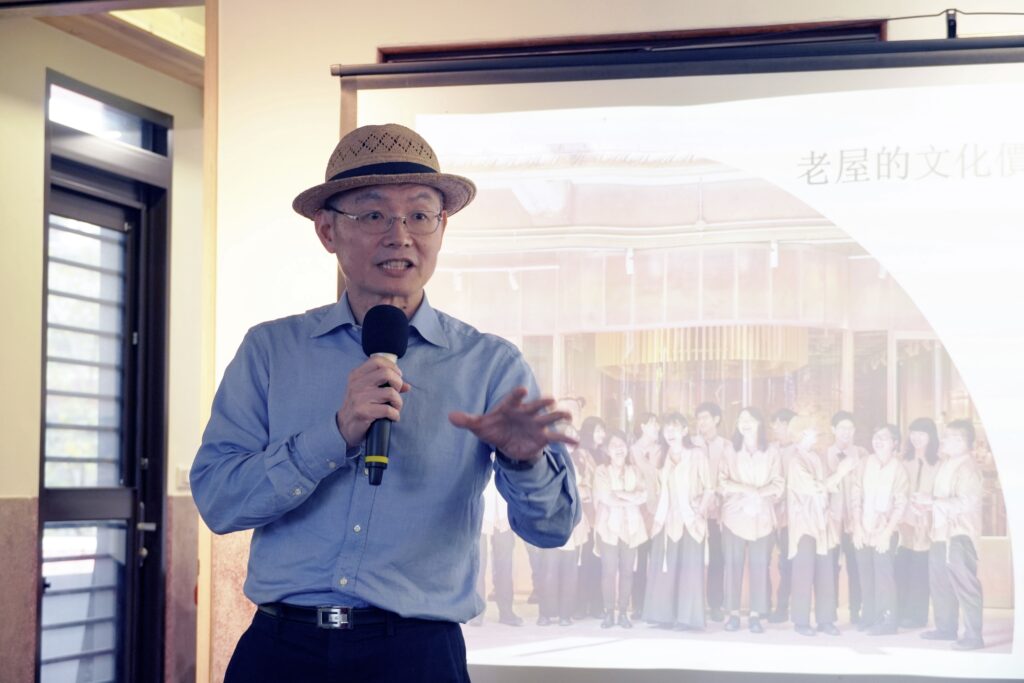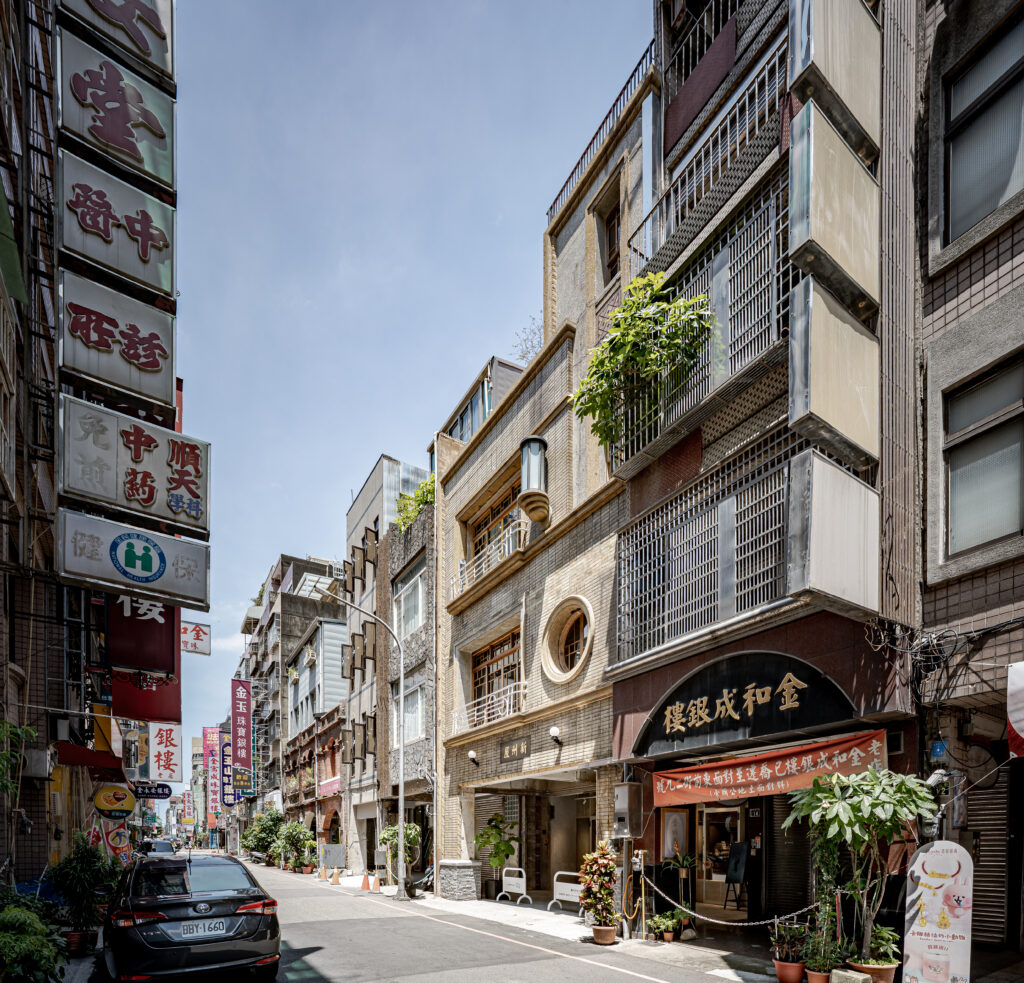Through early Hakka immigrants taking roots, the rise and fall of the tea industry, and ethnic interactions during times of transition, the alleys of Hsinchu’s Beipu wind through multi-layered historical foundations. How to preserve the intricate textures hidden beneath brick, tile, wood, and stone amid rapidly changing lifestyles has become a common yet thorny issue following local industrial transformation.
In view of this, the Beipu Township Office, which has long been involved in the preservation of cultural heritage and settlements, invited Professor Wu Chen-ting from the Department of Landscape Architecture, Chung Yuan Christian University and X-Base Planning in 2024 to explore the possibilities of harmonious coexistence between old houses and the local community. The team first selected five old houses with revitalization potential from the settlement preservation area, interviewed residents, and studied architectural techniques. While restoring the physical spaces, they also attempted to imbue them with public accessibility and openness, making these old houses windows for dialogue between contemporary life and repositories of historical memories.
To promote this concept, the team planned two training courses focusing on ‘Management of Old Houses’ and ‘Management of Local Communities’ under the theme ‘Reimagining Beipu’s Old Settlement.’ The first session invited the gifted class of Nanguo Elementary School in Changhua County – teachers Chen You-yu and Wu Chia-ming (Nanguo County Official Residence Revitalization Team), and Chen Tian-shun, Executive Director of Hongmei Culture Creativity Enterprise (manager of Huozhe Hsin Chow House), to share practical experiences at Beipu Blue Space and present visions for local regeneration with old houses as bases.
_250310_30_0-1024x768.jpg)
From Historical Site to Learning Base

Built in 1922, the ‘Nanguo County Magistrate’s Official Residence’ was originally the home of the Changhua County Magistrate and local officials, and witnessed the island’s administrative divisions and urban development during the Japanese colonial period, but fell silent for a time as eras changed. This forgotten Japanese-style architectural complex started its journey toward renewal in 2017 thanks to the initiative of Nanguo Elementary School’s gifted class. After eight years of continuous revitalization efforts and the collective work of many generations of students, it is now about to welcome a full-scale restoration project. Teachers Chen You-yu and Wu Chia-ming, who led the children into this historical space, shared their teaching and revitalization strategies during this training course.
The Nanguo County Magistrate’s Official Residence represents a unique and innovative restoration attempt from an educational perspective as well as the standpoint of cultural heritage preservation. The two teachers and their educational partners not only moved their classroom into the old house but also followed their existing teaching framework to create a series of on-site courses tailored for the children. Besides using mathematical knowledge to measure spaces, practicing Chinese language writing and expression, and understanding local history through surveys, they also arranged for experts and scholars to deliver lectures and lead walking tours, and collaborated with artists to help children create works based on the Nanguo County Magistrate’s Official Residence as exhibition content. X-Base Planning, which was still a youth action team at that time, was honored to participate in this project, assisting with exhibition planning and event execution.
For example, teachers and students of Nanguo Elementary School once invited a woodworking craftsman to demonstrate how to repair ‘shoji’ (Japanese wooden sliding doors), allowing children to personally experience the precision and delicacy of traditional woodworking. They also collaborated with artists to treat dust and moss accumulated over the years on the surrounding walls as a canvas, using steel brushes and templates to create ‘patina art,’ transforming the traces of time into environmentally friendly creative materials. The ‘Family Treasures’ exhibition invited community residents to share old objects and stories from their homes, gathering them into a public art piece that allowed the old house to once again become a space carrying collective memories. Through these participatory art actions, children were able to leave their mark on history and memories of the old house while naturally developing a sense of identity with the architectural complex.
These interactions with the old house were not just one-time courses or workshops, but evolved into sustainable shared memories passed down through generations. Nanguo Elementary School has a unique tradition: every year, third-grade students use the Nanguo County Magistrate’s Official Residence as a stage to perform the stories they have learned, felt, and created there for the next class of younger students, allowing the recording, interpretation, and recreation of local stories to be passed down from generation to generation as the children grow. Furthermore, the revitalization of the Nanguo County Magistrate’s Official Residence extends beyond the campus to the community. As teachers and students interviewed local elders, recorded oral histories, and activated the space through exhibitions, the previously abandoned and dilapidated building complex gradually regained recognition from surrounding residents. It has become a platform of diversity, connecting history with contemporary life, school with community, and culture with education, injecting the energies of creativity and revitalization rooted in the land into the neighborhood, while providing valuable inspiration for the future development of the Beipu settlement.

From Department Store to Cultural Landscape

Standing between Hsinchu’s East Gate Market and Central Market, ‘HAUS Hsin Chow House’ was originally the first department store designed, built, and operated by Taiwanese during the Japanese colonial period. When completed in 1934, it featured a trendy RC structure and asymmetrical facade design, embodying local living memories and the spirit of the era. However, as time passed, Hsin Chow House gradually lost its original texture through multiple changes in ownership and roles, even becoming a vacant space at one point, facing the heavy development pressure of the old city area. It wasn’t until 2019 that Chen Tian-shun, Executive Director of Hongmei Culture Creativity Enterprise, noticed this culturally precious old building and proactively purchased it as a private enterprise. After spending four years restoring Hsin Chow House, he illuminated its windows and doors under the ‘HAUS’ brand, making it another base for the ‘Distributed Art Museum’ project in Hsinchu’s old city area.
Before initiating the restoration project, the HAUS team collaborated with X-Base Planning to conduct in-depth research on Hsin Chow House—not only examining the building itself and carefully analyzing the changes and constants in its architectural design over decades, but also sorting out its historical context and cultural value, which became crucial starting points for the restoration project. Because of this, when we walk into HAUS Hsin Chow House today, we can still visualize the layout of the former department store operator’s residence from the different colored tiles on the third floor; we can also clearly identify traces of the current restoration from the subtle color differences in the textured bricks on the facade and the junction between new and old in the round window frames.
Additionally, to reconnect this old building, which carries the collective memories of Hsinchu residents, with contemporary life, the HAUS team organized three ‘Open House’ events. For the first event, they invited neighboring residents to enter the space before restoration work began, to experience the most original appearance of the old house and share stories that had unfurled there. For the second event, Hsin Chow House was transformed into an exhibition venue for Taiwan Design Expo, presenting diverse food cultures in a preliminarily organized old house space. For the third event, just before the full-scale restoration project began, the HAUS team presented ‘Farewell to Hsin Chow House,’ showcasing the old building’s history, architectural features, and vision for future revitalization to the public. These three Open House events not only gradually awakened long-dormant local memories but also connected the past, present, and future of the old house, allowing different generations of Hsinchu residents to find their own memories and emotional connections here.
Officially opened in 2023, ‘HAUS Hsin Chow House’ showcases a skillful blend of historical space with contemporary design, becoming a distinctive cultural landmark in Hsinchu’s old city area. Through its select shop, restaurant and bar, themed bookstore, and co-creation kitchen, it reinterprets Hsinchu’s local culture and food traditions.

From ‘HAUS Bookstore’ in the Xinwawu Hakka Cultural Preservation Area in Zhubei, ‘HAUS Craft Window’ and ‘HAUS Hsin Chow House’ in Hsinchu’s old city area, to the recently opened ‘HAUS Mountain Journey’ in Beipu, Hongmei Culture Creativity Enterprise’s vision of building a ‘Distributed Art Museum’ remains unchanged—hoping to weave a local cultural network through customized management of diverse old house spaces, introducing culturally rich living industries to marginal townships, and helping local residents rediscover their sense of identity and pride in their land.
Looking at the long accumulation of educational foundations at Nankuo County Magistrate’s Residence and the HAUS team’s commercial practices centered on culture, it’s clear that the revitalization and regeneration of old houses often require long-term investment and multi-party collaboration. As we shift our perspective back to Beipu, lessons acquired from these cases demonstrate that we need to deeply understand the unique local context, balance cultural preservation with commercial development, build consensus, and take action.

